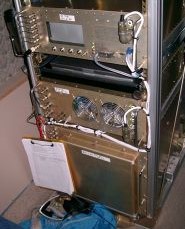The ORNL DAAC recently released a datset from the Atmospheric Tomography (ATom) Mission developed by Stephens, B.B., et al. (2021):
ATom: L2 In Situ Measurements from the NCAR Airborne Oxygen Instrument (AO2), V2
This dataset provides in situ atmospheric oxygen and carbon dioxide concentrations measured by the NCAR Airborne Oxygen Instrument (AO2) during airborne campaigns conducted by NASA's Atmospheric Tomography (ATom) mission. The AO2 instrument is designed specifically for airborne use to minimize motion and thermal sensitivity and with a pressure and flow controlled inlet system. AO2 has a 1-sigma precision of ± 2.5 per meg on a 5-second measurement. For comparison, this is equivalent to detecting the removal of one O2 molecule from 2.5 million molecules of air. This and other ATom datasets are used to improve the representation of chemically reactive gases and short-lived climate forcers in global models of atmospheric chemistry and climate.
ATom was a NASA Earth Venture Suborbital-2 mission to study the impact of human-produced air pollution on greenhouse gases and on chemically reactive gases in the atmosphere. ATom deployed an extensive gas and aerosol payload on the NASA DC-8 aircraft for systematic, global-scale sampling of the atmosphere, profiling continuously from 0.2 to 12 km altitude. Around-the-world flights were conducted in each of four seasons between 2016 and 2018.
Additional data from ATom and other relevant links can be found on the ORNL DAAC's ATom Project Page.
Citation: Stephens, B.B., E.J. Morgan, A. Watt, J. Bent, S. Afshar, R.F. Keeling, and W. Paplawsky. 2021. ATom: L2 In Situ Measurements from the NCAR Airborne Oxygen Instrument (AO2), V2. ORNL DAAC, Oak Ridge, Tennessee, USA. https://doi.org/10.3334/ORNLDAAC/1880

